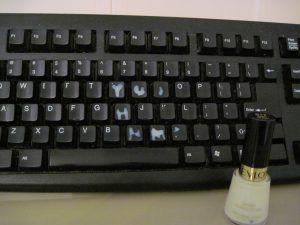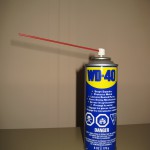“Oh my God,” he said as soon as he sat down.
I looked over with alarm. I’d hired a computer tech to fix what I thought were some minor problems. But this sounded serious. Perhaps even terminal.
“What’s the matter?” I asked.
“I’ve never seen such a degraded keyboard,” he replied.
He was right. The y, u, I, h, k, n and m letters were totally worn off. They must be used in a lot of words. Not having them didn’t bother me. I rarely look at the keyboard when I type. But friends and family teased me about it whenever they came to visit and used my computer.
One day I remembered I had a bottle of Sheer Heaven in the bathroom cabinet. Working carefully, I used the white nail polish to paint thick, but legible, letters on my keyboard. Everyone thought that was pretty funny.
 When I got a cheque for Christmas marked “new keyboard,” I knew it was time to move on. But it was hard to let go of the old one. I estimated that during the six years I’d had it, I’d written two books and 400 articles. That adds up to 435,000 words or so. No wonder some letters were worn off.
When I got a cheque for Christmas marked “new keyboard,” I knew it was time to move on. But it was hard to let go of the old one. I estimated that during the six years I’d had it, I’d written two books and 400 articles. That adds up to 435,000 words or so. No wonder some letters were worn off.
Like many people who sit in front of a computer all day, I have chronic back problems. So, after some research, I bought an ergonomic keyboard.
It was all flowing curves and – if I only knew how to use them – had enough bells and whistles on it that I could probably fly to the moon.
But you know what? For some reason the ergonomic keyboard made my back pain worse. After three weeks of adjusting my chair and tilting the keyboard this way and that trying to make it work, I returned it.
That’s right; I’m using the keyboard with the nail polish letters again. It feels comfortable but seems annoyingly noisy compared to its modern cousin.
A new keyboard is still in the works. In fact, I’ve got my eye on a sleek little black number that promises to be easy on the back and ultra quiet. All I have to do is say goodbye to the old keyboard. Again.


